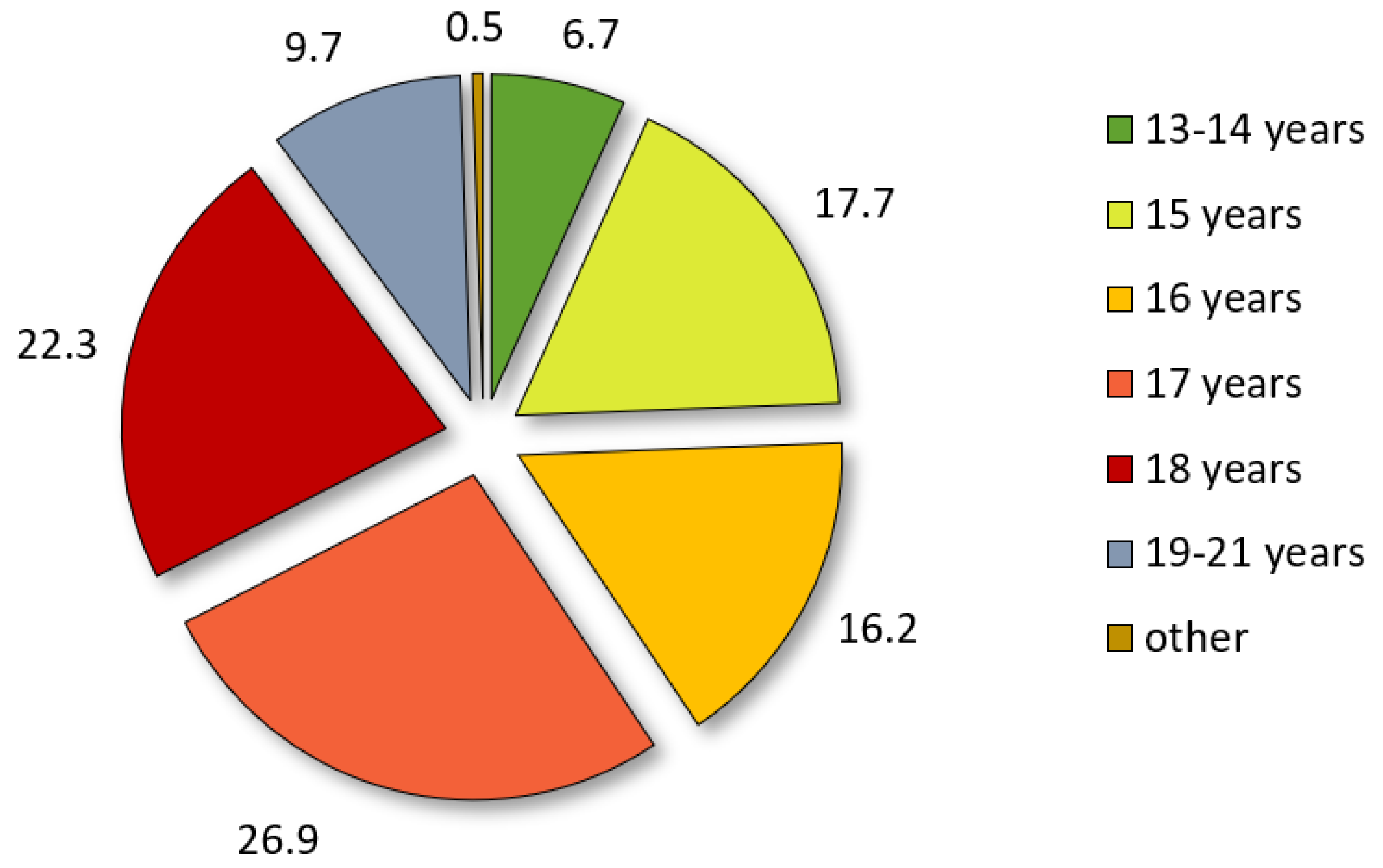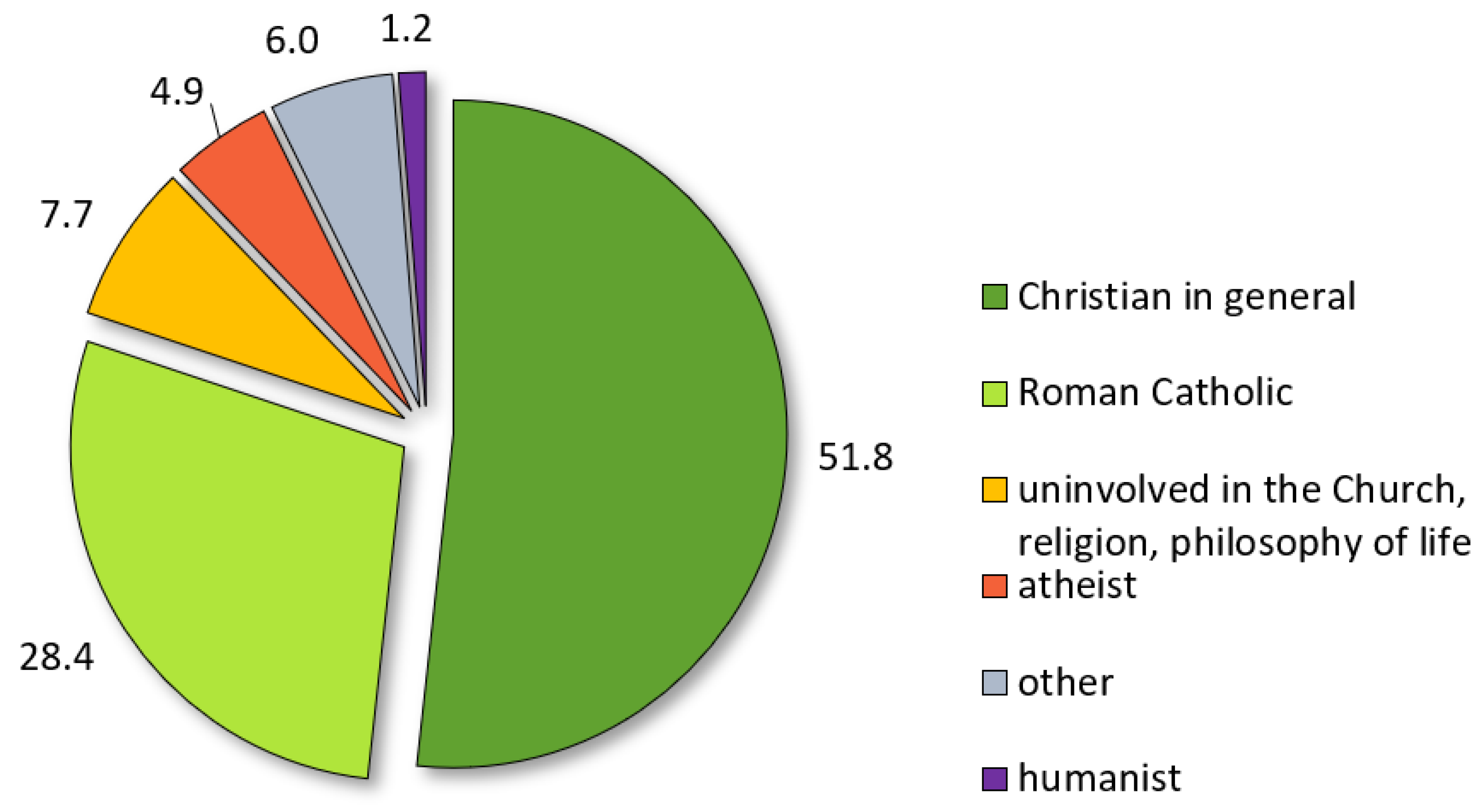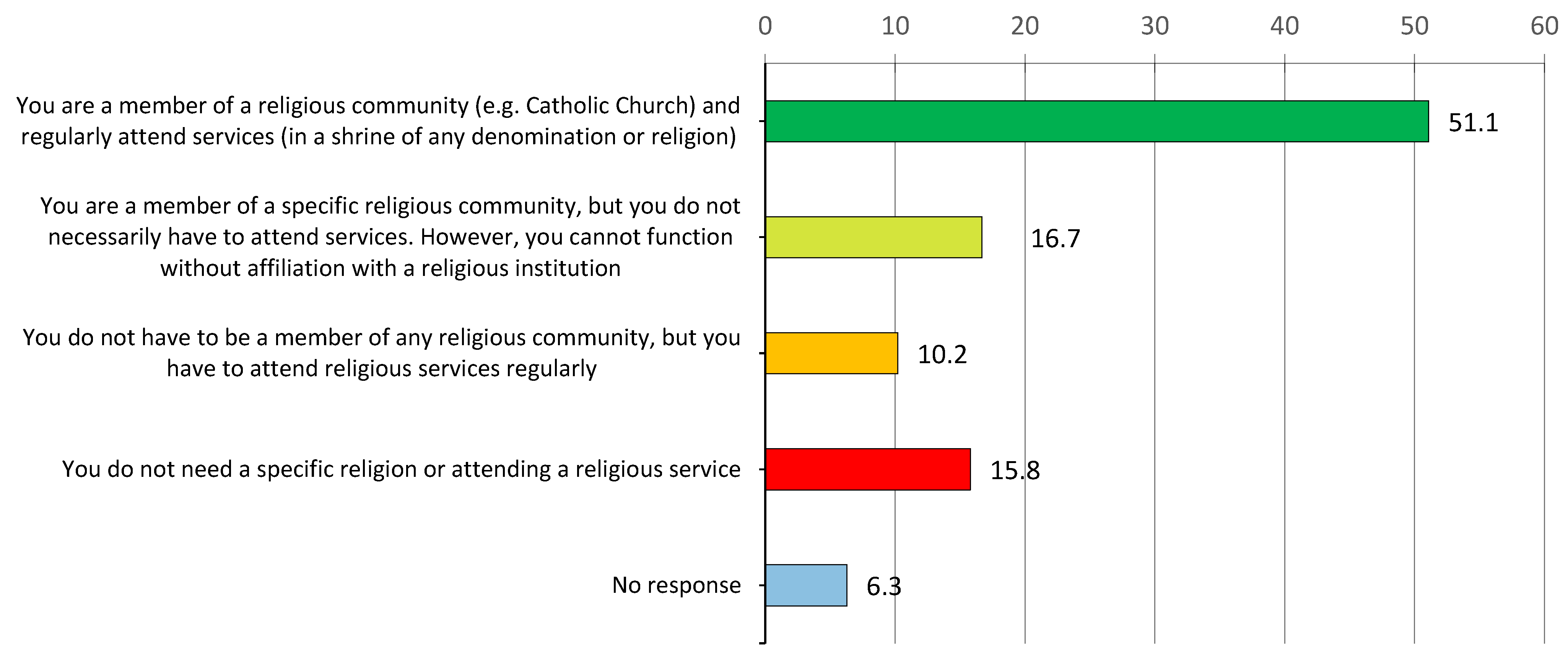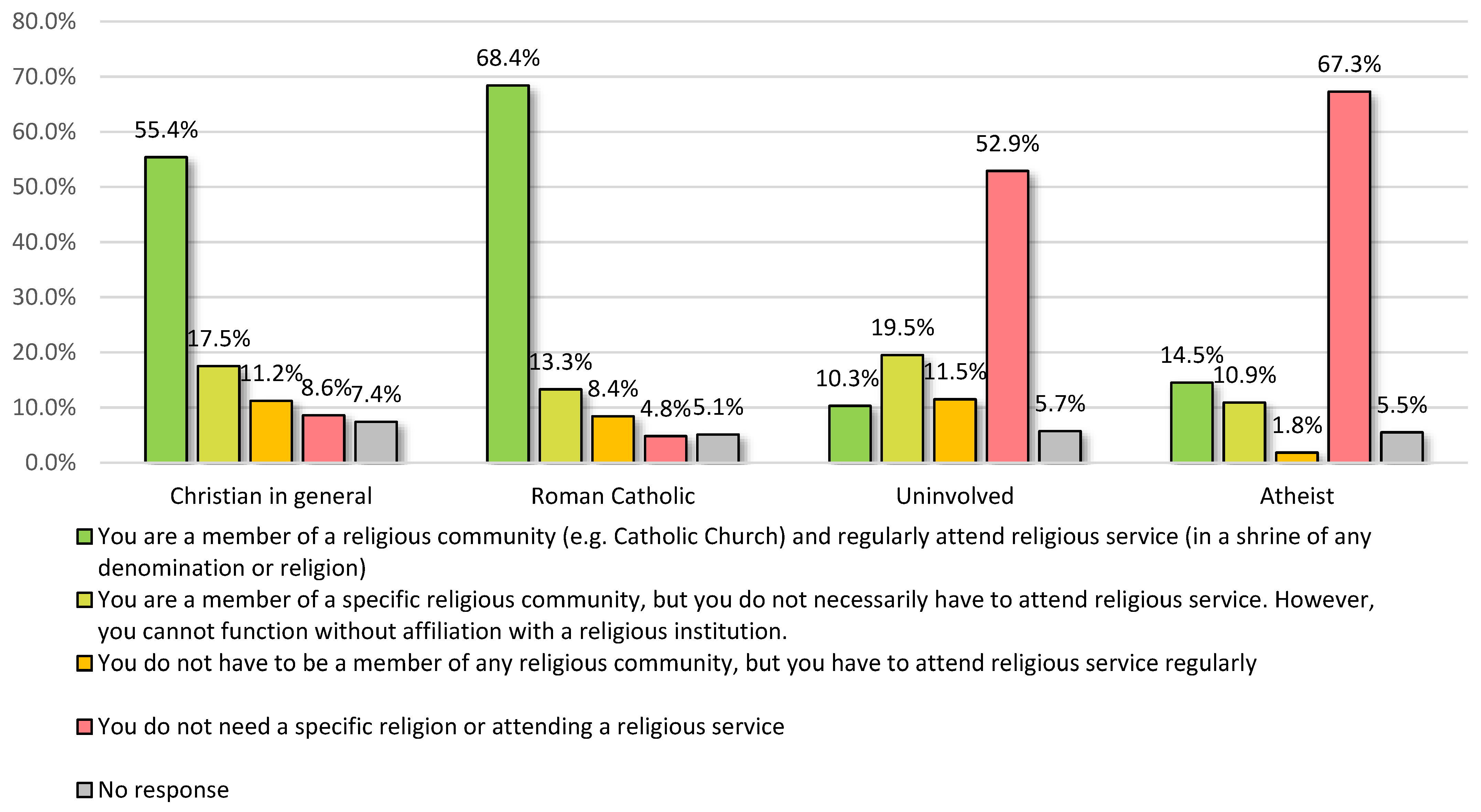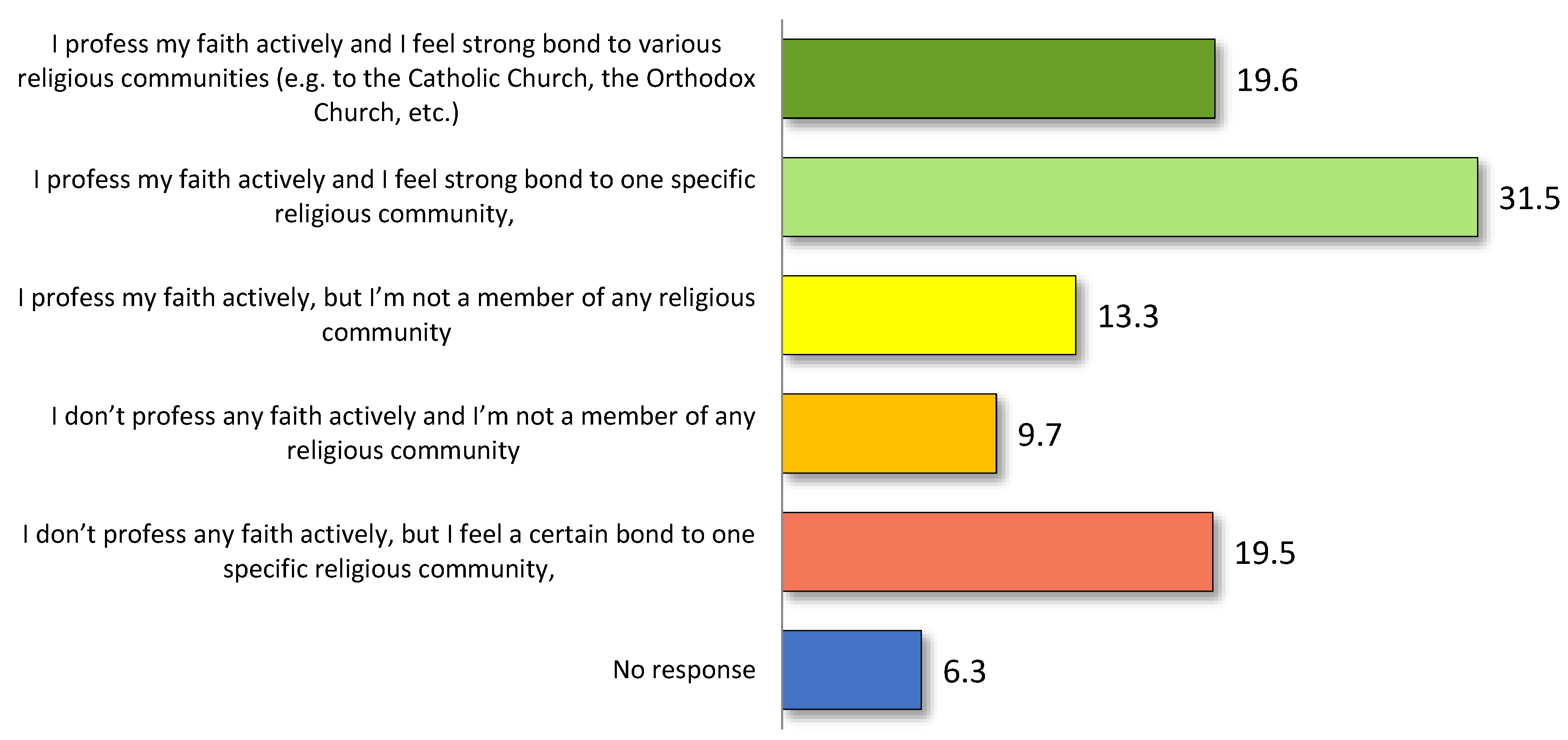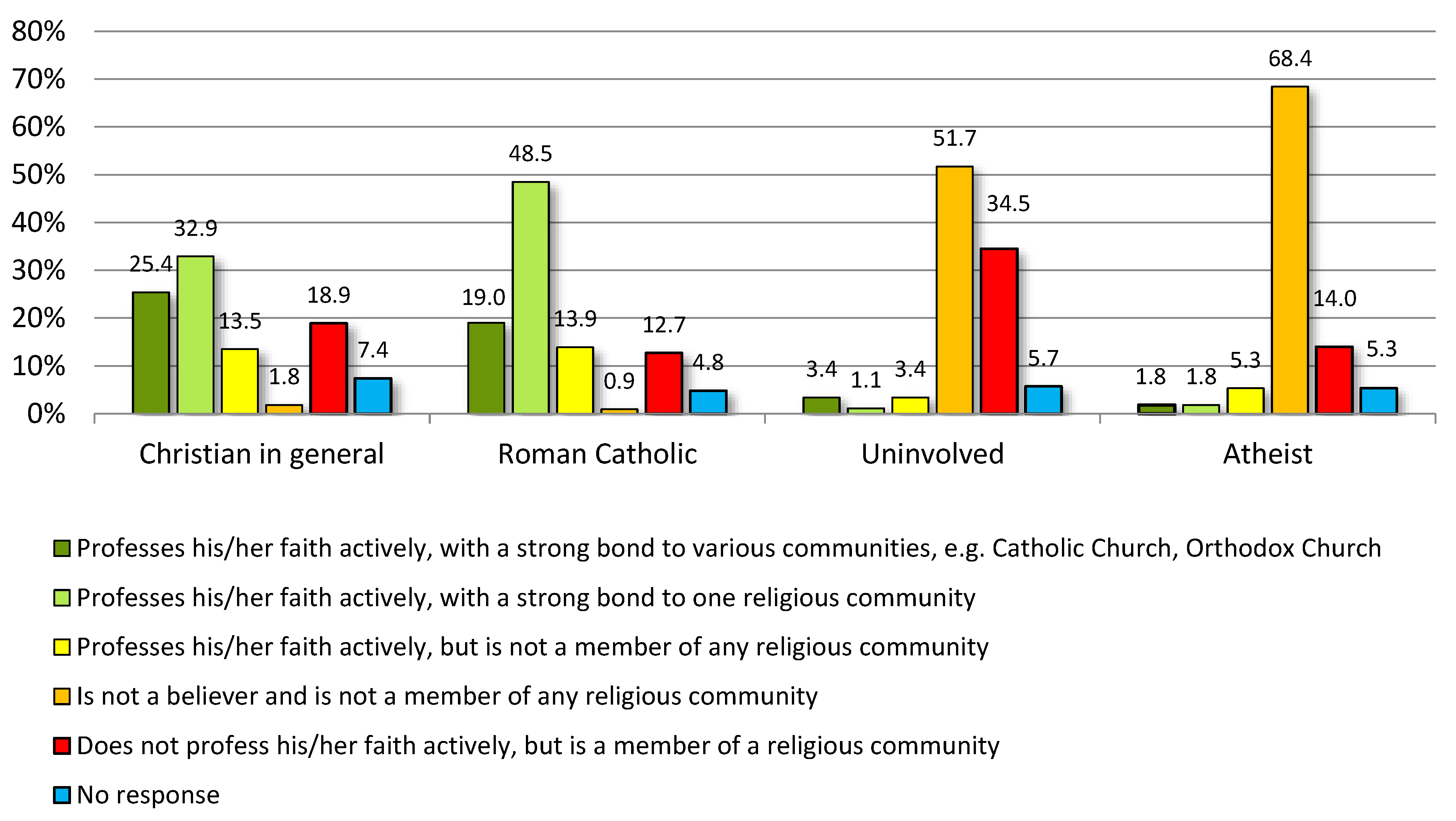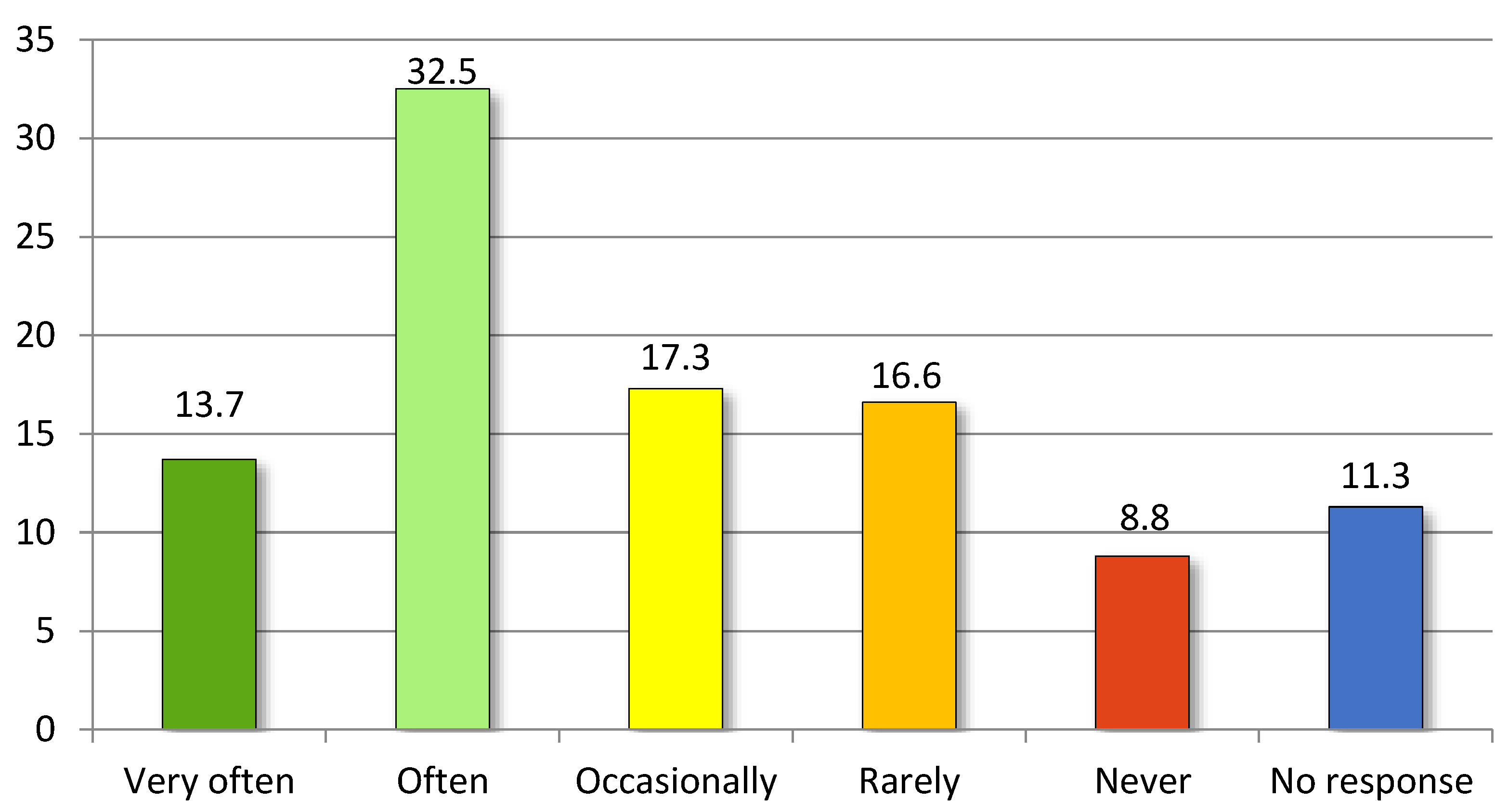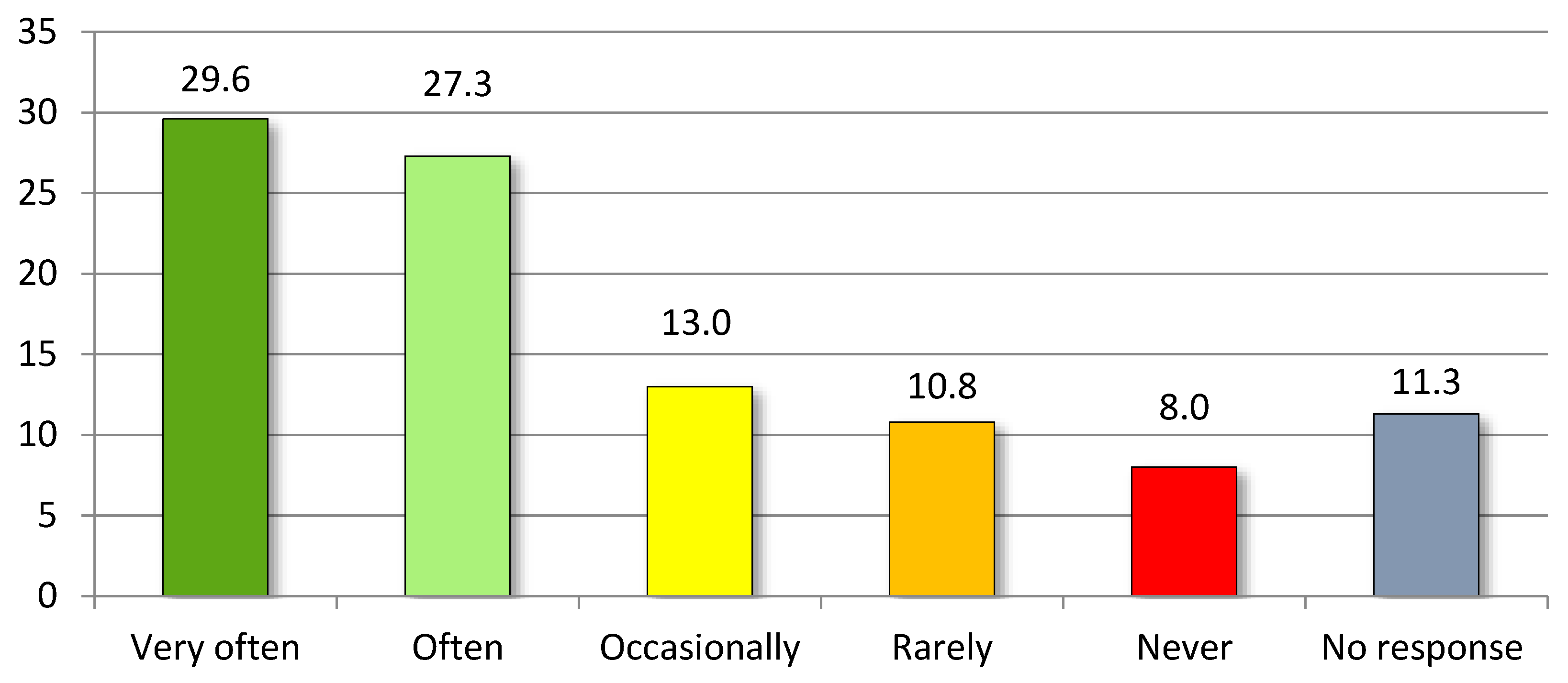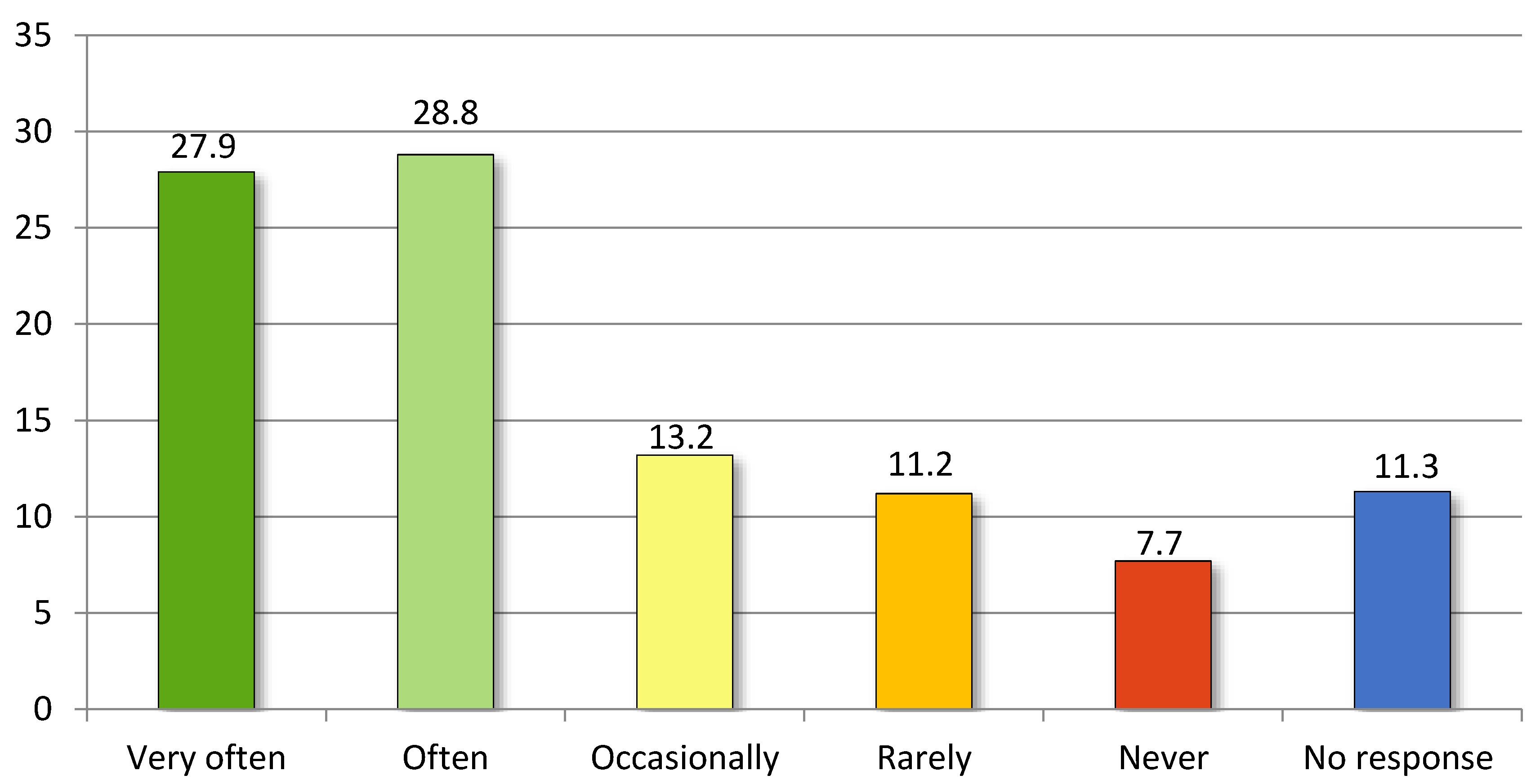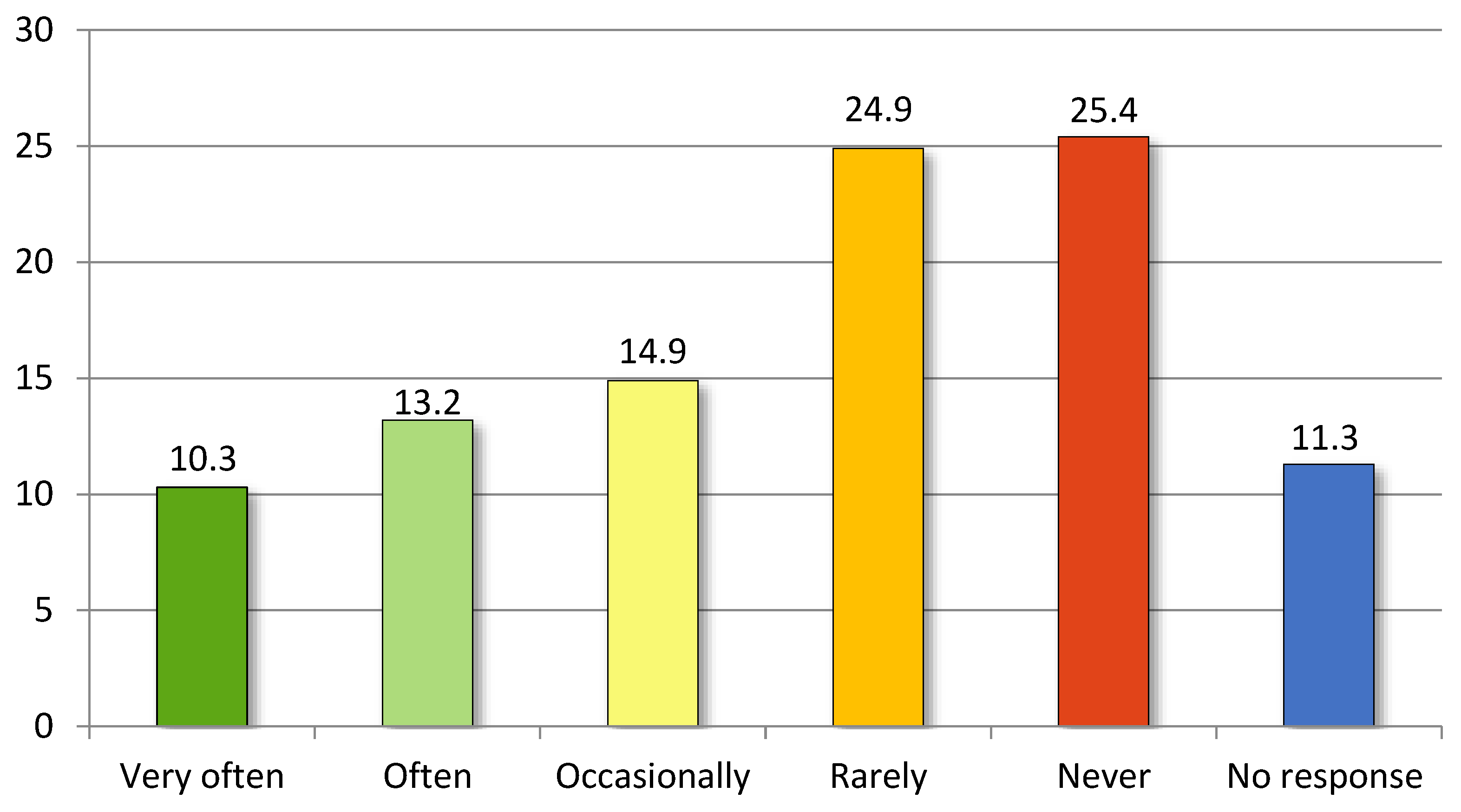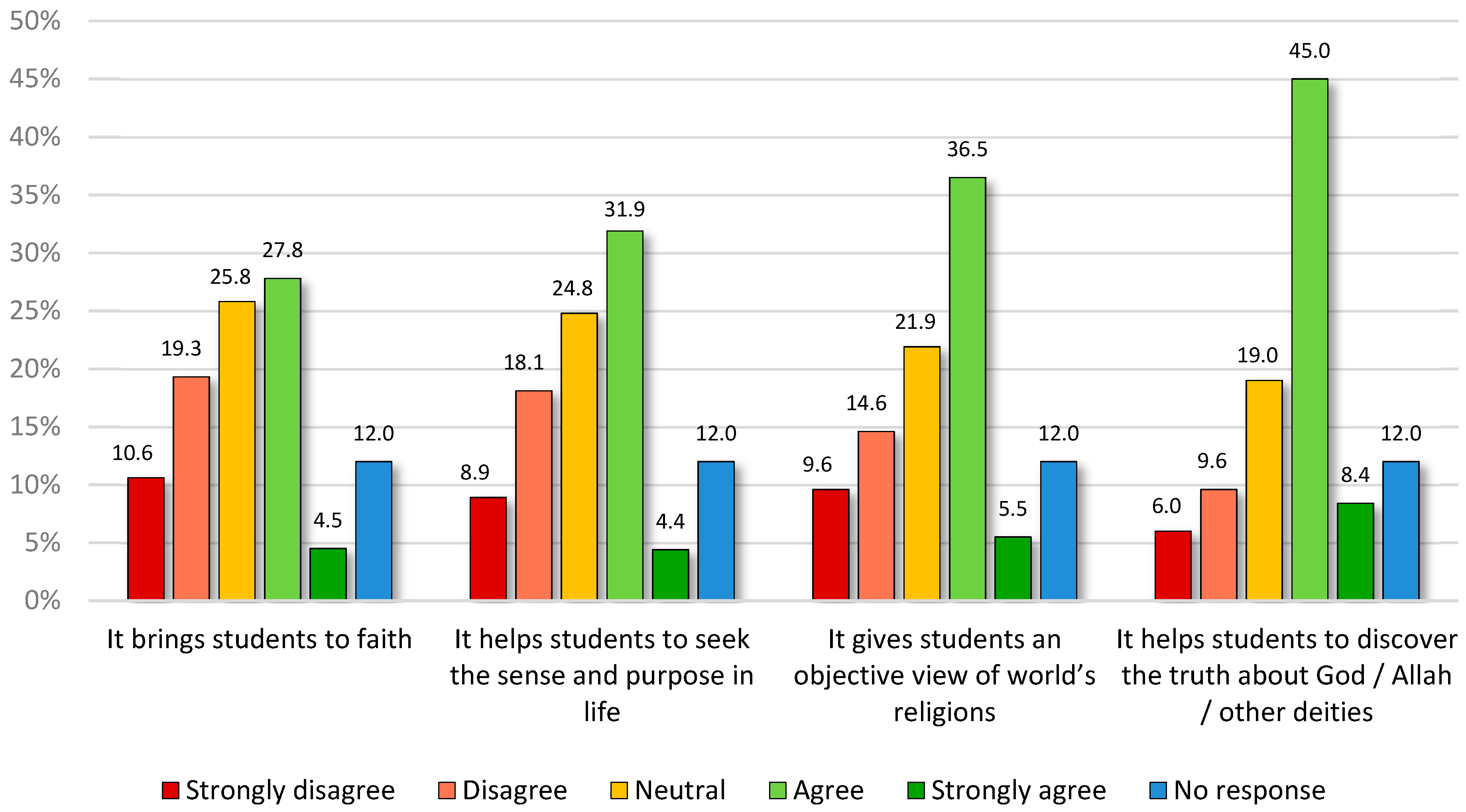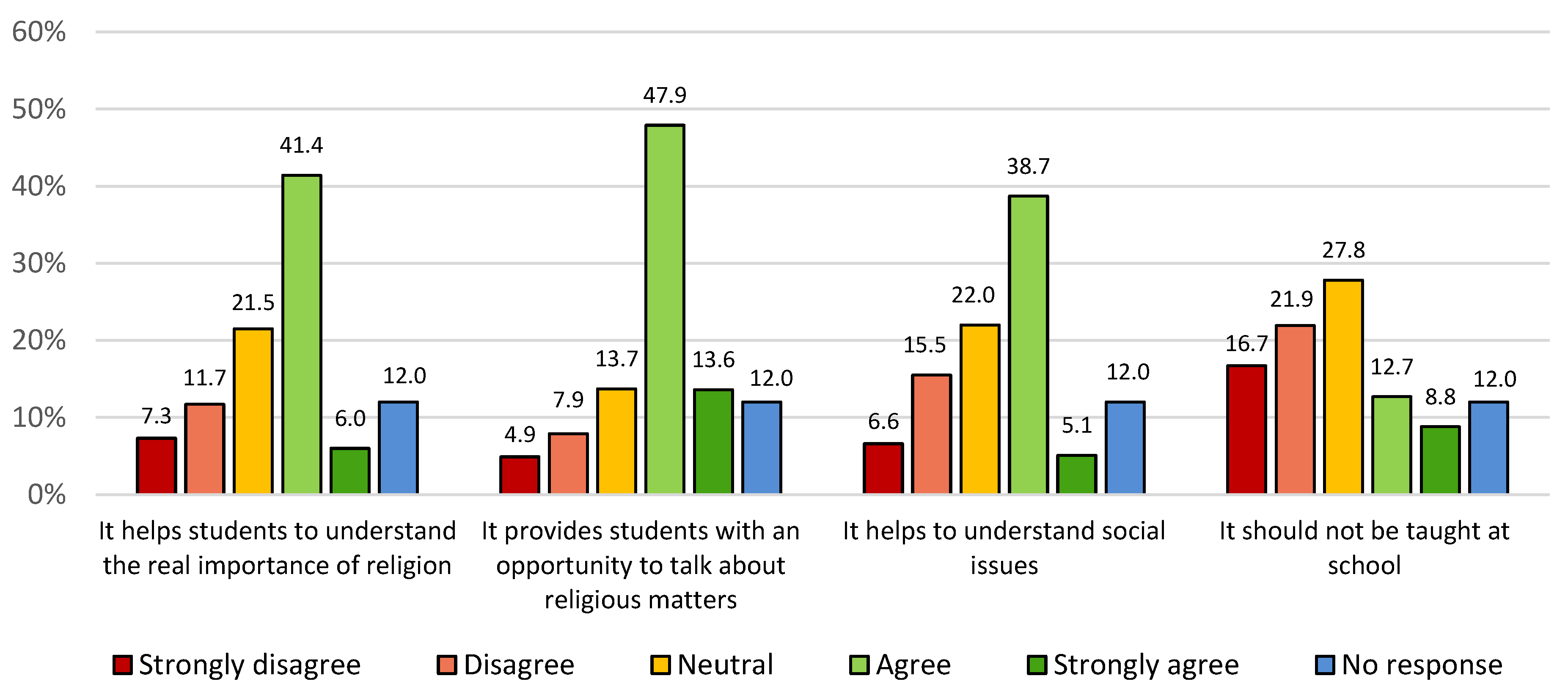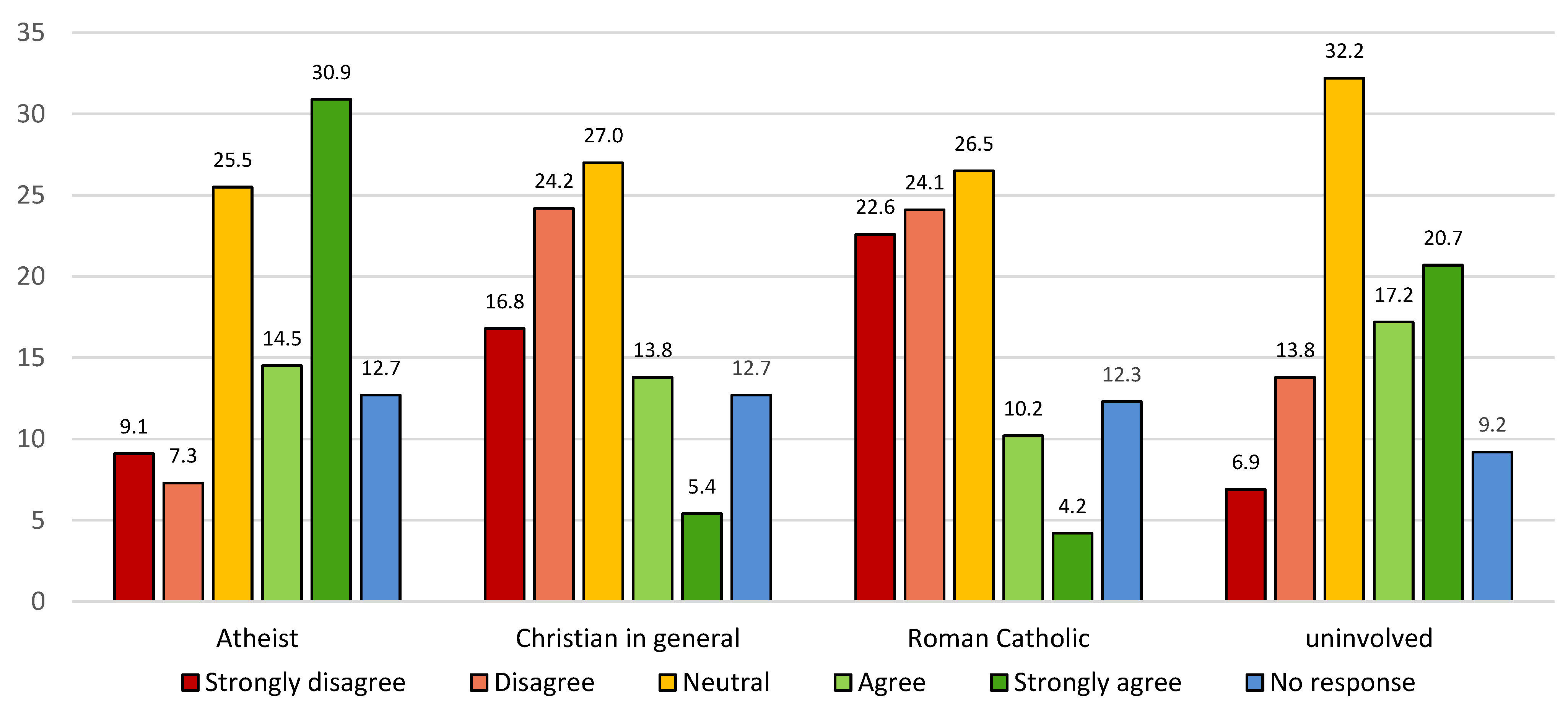5. Analysis of Empirical Data
The results of empirical studies apply to the religiousness parameters—selected, understandable to contemporary youth, and relatively easy to diagnose. Some of them will be presented in correlation with the self-declaration of the professed religion.
In order to define their attitude to religion, the young people under study had fifteen categories to choose from: Christian, Roman Catholic, Orthodox, Lutheran, Jew, Sunni, Shi’ite, Alevi, Muslim, Buddhist, Hindu, uninvolved in any church, religion or philosophy of life, atheist, humanist or other religious or non-religious philosophy of life. Although Roman Catholicism is considered to be one of the Christian churches, as well as Orthodox or Lutheran, these categories have been distinguished here to estimate whether the respondents place themselves in a wider, multidenominational category or rather choose a specific community. As a result, the strength of their religious self-assignment can be assumed, taking into account divisions within Christianity. These Roman Catholics, as representatives of the largest religious group in Poland, who assign themselves to Christians, may seem less attached to denominational differences and more to common Christian values, but this hypothesis requires a deeper study. However, classifying oneself into one of the mentioned above groups required the respondents to be able to look into themselves, self-reflect, and to be able to evaluate the reality of their own faith. Therefore, the declarations of the young people under study are introspective and subjective. All of the respondents gave their responses to these questions. In total, they declared themselves to be Christians in general (51.8%), Roman Catholics (28.4%), uninvolved in the church, religion, philosophy of life (7.7%), atheists (4.9%) or others (1.2%)
1 (
Figure 2). Self-declaration of the professed religion. Nearly two-thirds of the respondents are young people who see themselves as Christians and Roman Catholics. The other individuals declare uninvolvement or even atheism.
In order to examine the attitude of the youth under study toward the religion they profess, they were asked about their affiliation with a religious community (
Figure 3).
The respondents had four responses to choose from. The largest portion of respondents (51.1%) declared to be members of a religious community (e.g., the Catholic Church) and to attend religious services (in a church or other shrine) This can be compared to a 2018 Polish national youth survey according to which 63% of 18–19 y.o. declared as being religious or deeply religious and to a similar 2021 survey that unfolded a 9% drop to 54% religious youth (cf.
CBOS 2019,
2022). The study group also included individuals who declared affiliation with a specific religious community, but they did not have to attend religious services (16.7%). They emphasised that they could not live without an affiliation with a religious institution. Moreover, 15.8% of the respondents claimed that they did not profess a specific religion or attend religious services. In turn, 10.2% declared not being a member of any religious community but that they had to attend religious services regularly (compare: Figure 10 below), and 6.3% of the respondents did not respond. Therefore, it is obvious that a large group (42.7%) of the respondents are influenced by the processes of secularisation, individualisation and privatisation of faith and liberal culture. They are guided by a subjective approach to the religion they profess, and they do not see religious practices as necessary. Considering this, it is worth looking at the self-declarations of affiliations with a religious community in correlation with a self-declaration of the professed religion (
Figure 4).
The highest percentage of those declaring themselves as Christians in general are those who respond that they are members of a religious community and attend religious services in a shrine regularly (55.4%). Therefore, more than half of the individuals declaring themselves to be Christians in general demonstrate a consistent approach to faith and religious involvement. Far fewer Christians in general under study declare that they are members of a specific religious community, but they do not necessarily have to attend religious services. However, they cannot live without an affiliation with a religious institution (17.5%). This may indicate a considerable motive for affiliation with a group and identification with a specific circle without a strictly religious reference, based on a personal relationship with God. Therefore, it seems that, in this case, affiliation with a religious community is more emotional than rational and not yet preceded by conscious reflection or decision. This type of behavior is typical of adolescence. It is puzzling that there is a high percentage (11.2%) of respondents who do not have to be members of any religious community, but they have to attend religious services regularly. The smallest portion of those declaring to be Christian (8.6%) do not need a specific religion or to attend religious services.
Affiliation with a religious community as correlated to a self-declaration of faith was the most marked among Catholics. As many as 68.4% of the respondents declaring themselves to be Catholics claimed to be members of a specific religious community and to attend religious services regularly. Only 4.8% of the Catholics under study do not need a specific religion or to attend religious services. This group also contains a puzzlingly high percentage (8.4%) of respondents who do not have to be members of any religious community, but they have to attend religious services regularly. A question arises: Is this caused by a certain type of traditional religiousness—“cultural obviousness”—inherited from one’s parents? May it be a consequence of a certain pressure from one’s parents or grandparents? The data in
Figure 4 show that individuals with more established convictions belong to two polarised, opposite groups: Roman Catholics and atheists. This may indicate the tight-knit nature of the group of their fellow believers, sharing similar views, or greater confidence in the declared views (possibly together with a lower ability to establish open dialogue; however, this cannot be inferred from the study), as opposed to people with more flexible views, as Christians in general and the uninvolved, potentially more labile and prone to change those declarations. The latter can still hesitate about which side to choose—whether to join the others or to keep a distance. The responses of those who declared being uninvolved religiously are rather predictable—52.9% of the respondents claimed that they did not need a specific religion or to attend religious services. A much smaller percentage of the respondents—19.5%—do not have to attend religious services despite a sense of affiliation with a religious community (institution). Such declarations are justified in the group of uninvolved individuals. Further responses were surprising—11.5% of the religiously uninvolved respondents, who declared not being members of any religious community, also declared attending religious services regularly. 10.3% of the religiously uninvolved respondents declared to be members of a religious community (e.g., the Catholic Church) and attending religious services regularly (in a church or other shrine), which may be surprising. It seems that those declared to be religiously uninvolved, like Christians in general and Catholics, although to a smaller extent, choose what suits them best and treat religion like one of many activities to choose from.
This picture is complemented by the responses of individuals declaring themselves to be atheists. Obviously, the largest group of respondents (67.3%) claimed that they did not need a specific religion or to attend religious services. The most puzzling responses are those of 14.5% of the atheists, who claimed to be members of a religious community (e.g., the Catholic Church) and to attend religious services in a shrine regularly. In light of these data, one can suppose that the respondents did not believe in God, and they regard religion as contrary to science and reason, but they do not discard outer forms of religiousness for some reasons. This may also be motivated by non-religious factors, such as: the beauty of sacred music and architecture or regarding a shrine as a place where one can experience peace and quiet and find inner harmony. These self-declarations may also show a lack of consistency between one’s beliefs and outward behaviours (attitudes).
The self-declaration of faith and affiliation with a religious community is interesting (
Figure 5).
Professing one’s faith actively and a feeling of a strong bond to one specific religious community was declared by 31.5% of the respondents, and 19.6% of them professed their faith actively and felt a strong bond to various religious communities (e.g., Catholic Church, Orthodox Church, etc.). A similar percentage of the young people under study (19.5%) declared not to profess any faith actively but felt a certain affiliation with one specific religious community. The responses chosen by those who claimed to profess their faith actively but not to be members of any religious community (13.3%) are puzzling. 9.7% of the respondents declared not to profess any faith actively and not to be members of any religious community. These statements reflect the young people’s courage in their religious self-declarations. They also testify to the individualisation of faith and the possible abandoning of the institutional framework of religion. No response was provided by 6.3% of the young people taking part in the study. This may be caused by the difficulty they face when self-declaring their faith and affiliation with a religious community or a reluctance to answer questions about their faith and bond to any religious community.
Very interesting conclusions can be drawn from an analysis of self-declarations of faith and affiliation with a community in correlation with a self-declaration of the religion one professes (
Figure 6).
The largest percentage of the declared Christians in general (52.0% of the total study population) responded that they professed their faith actively and felt a strong affiliation with a specific religious community (32.9%). A little smaller percentage of them (25.4%) were those who professed their faith actively and felt a strong bond to various religious communities (e.g., Catholic Church, Orthodox Church, etc.). Moreover, 18.9% of the respondents declared not professing any faith actively but felt a certain affiliation with one specific religious community. Probably, in some cases, those are non-practicing or hardly practicing believers. It is notable in this context that 13.5% declared not to be members of a religious community while professing their faith actively. They must be respondents whose faith and religious practices have an individual and subjective dimension. They value their autonomy and freeing themselves from the influence of tradition. The attitudes of the others are more stable. Only among the Roman Catholics is affiliation with a group unrelated to professing one’s faith actively high enough (12.7%) to indicate that it satisfies the need for social belonging and acceptance, and this is seen by this group of respondents in the church community. A relatively small percentage (1.8%) of the declared Christians in general did not profess any religion actively and were not members of any religious community. In some cases, these are certainly respondents who—despite having been baptised—do not identify themselves with faith and they do not want to publicly declare their affiliation with a religious community. This is different from declared Catholics (28.0% of the total study population). In this case, a definitely larger percentage (48.5%) are those who declared that they professed their faith actively and felt a strong bond to one specific religious community. At the same time, 19.0% of this study group declared professing their faith actively and felt a strong bond to various religious communities (to the Catholic Church, the Orthodox Church, etc.). Furthermore, 13.9% of Roman Catholics declared professing their faith actively while not being members of any religious community. This may indicate that the phrase “religious community” was considered by the responders not to be synonymous with “official religion” but rather to be identical with small religious groups and/or movements within the certain religious organisation. It is interesting that 12.7% of the declared Roman Catholics did not profess any faith actively, but they felt a certain affiliation with one specific religious community. These are certainly non-practicing individuals. It is also notable that 4.8% of the declared Roman Catholics did not provide any response, and 0.9% claimed not to profess any religion actively or to be members of any religious community. This latter group of respondents can be perceived as religiously indifferent individuals. The responses of religiously uninvolved individuals (8.0% of the study population) are also noteworthy. Over half of the respondents (51.7%) in this group declared not to profess any religion actively and not to be members of any religious community. Far fewer of those religiously uninvolved (34.5%) responded that they did not profess any faith actively but that they felt a certain affiliation with a specific religious community, which indicates their indecisiveness, non-established convictions but inclined somehow to seek for a kind of religiousness. Only 3.4% of religiously uninvolved respondents declared that they professed their faith actively and that they felt a strong affiliation with various religious communities (e.g., the Catholic Church, the Orthodox Church, etc.), and the same percentage (3.4%) responded, “I profess my faith actively and I am not a member of any religious community”. The fewest religiously uninvolved respondents (1.1%) declared that they professed their faith actively and they felt a strong bond to one specific religious community. The religiously uninvolved individuals who did not provide any response accounted for 5.7%. These data do not in any way indicate an advanced process of individualisation and pluralisation of religion. They suggest that also for young, religiously uninvolved people, faith and affiliation with a religious community become an object of important, individual considerations, leading to individual choices and preferences. It is also notable that 68.4% of the declared atheists did not profess any faith and were not members of any religious community. Such declarations are justified, and they arise from the very essence of atheism. At the same time, 14.0% of the respondents in this study group declared not to profess any faith actively but did feel a certain affiliation with one specific religious community. This may come from family and/or social traditions. There are some puzzling responses in which declared atheists responded that they professed their faith actively and that they were not members of any religious community (5.3%), they professed their faith actively, and they were strongly bonded to various religious communities (1.8%). Self-declarations may be a manifestation of the lack of consistency between one’s inner convictions and attitudes, and a full explanation would require further studies. The rate of the lack of response is also notable (5.3%). Possibly, the respondents in this group have some problems with justifying their self-declarations.
The next responses of the young people in the study group concerned their religious practices. The study focused on selected, regular and occasional religious duties. Therefore, the respondents were first asked whether they often attended religious services/celebrations/masses (in a synagogue, church, mosque, etc.). The results are shown in
Figure 7.
The results indicated that 32.5% of the respondents declared attending religious services frequently. The other respondents attended such services very frequently (13.7%), from time to time (17.3%), rarely (16.6%) or never (8.8%). 11.3% of the respondents did not respond. In order to obtain more data on this issue, the respondents were asked to answer whether they attended religious services/celebrations/masses (in a synagogue, church, mosque, etc.) on major holidays. The answers are shown in
Figure 8.
Practicing believers account for 56.9% of the whole study population, including 29.6% who declared that they attended religious services on major holidays (understood as holidays regarded as the most important ones in a specific religious tradition) very often, and 27.3%—often. Only 13% of the respondents attended religious services on major holidays from time to time, 10.8%—rarely, and 8.0%—never. As many as 11.3% of the respondents did not answer this question. Possibly, the young people taking part in the study—while experiencing a relatively strong bond with God and with the ecclesial community—do not abandon the obligatory religious practices en mass in favour of their individual preferences. This is probably affected by various social and cultural factors, especially one’s family situation. Therefore, the respondents were asked: do your parents attend religious services/celebrations/masses (in synagogue. church, mosque, etc.)? The answers are shown in
Figure 9. According to this, 28.8% of the parents often go to religious services, 27.9% of them do it very often, 13.2%—from time to time, 11.2%—rarely and 7.7%—never, and 11.3% of the respondents did not respond. The respondents’ declarations about their parents attending religious services/celebrations/masses are diverse.
There is still a vertical transmission of religious attitudes, although it is weakened.
Figure 9 shows that there is a 10% deficit of religious practices in the vertical transmission between the parent and children generations.
The respondents’ declarations on the frequency with which their parents attend religious services show that their parents’ attitude to faith and religious practices is very important. This is also a conclusion drawn from the responses to the following question: have your parents ever made you attend religious services/celebrations/masses? (
Figure 10).
Interestingly, 24.3% of the respondents declared that their parents had never made them attend religious services/celebrations/masses, and 24.9% responded that they had done it rarely, while 14.9% of the respondents declared that their parents had made them attend religious services/celebrations/masses from time to time, 13.2% responded that they had done it often, 10.3%—very often, and 11.3% of the respondents did not answer. According to
Figure 9, there are a total of 56.7% practicing parents (the sum of the “often” and “very often” responses).
Figure 7 shows that there are 46.2% of practicing young people (very often and often). This gives a 10.5% deficit, which leads one to the conclusion that the example provided by parents is met with more effective neutralising tendencies, which include the impact of mass culture or other factors which were not analysed in this study. Moreover,
Figure 10 shows that more than half of the respondents had not been made to attend religious practices (rarely + never = 50.3%). This means that the parents practicing and giving an example with their actions and religious education were more frequent than making young people attend religious practices. Therefore, one can conclude that the bond to religious traditions and practices is still strong in the south and south-east of Poland, i.e., the regions under study, especially in the generation of the respondents’ parents, although this bond diminishes in the vertical transmission. This tendency can be demonstrated in further studies.
Bearing in mind that individual prayer is an important manifestation of one’s religiousness, the respondents were asked whether they pray, how often and when. The responses show that the respondents’ attitudes to these issues varied (
Figure 11).
A total of 51.8% of the respondents pray in bed in the evening (20.2% pray from time to time, 16.7%—very often, 14.9%—often), 18.8%—never, and 18.2%—hardly ever. Praying was not associated with the meal ritual. 52.9% of the respondents never pray before and/or after meals, 21.9%—hardly ever, and 14.1% of them admit that they pray (10.3%—from time to time, 2.5% often, 1.3% very often). Fear is not a motive for praying for 23.3% of the respondents. It seems to be a very weak motivator for praying for 14.8% of the respondents who chose the “hardly ever” response. However, as many as 50.7% of the respondents pray when they are anxious or concerned, including 21.7%—from time to time, 15.8%—often, 13.2%—very often. Furthermore, 29.8% of the respondents declared that they never prayed when they were sad. However, as many as 40.9% of the respondents pray when they sad (19.7% pray from time to time 13.4%—often, 7.8%—very often). When they are happy, 19.6% of the respondents pray from time to time, 15.3%—hardly ever, 14.9%—often, 5.2%—very often. No praying when they were happy was declared by 33.8% of the respondents. Gratitude is a reason for praying for 53% of the respondents (23.1% pray from time to time when they are grateful, 20.8%—often, 9.1%—very often), 11.7% hardly ever pray in such situations, and 24.0% of the respondents never pray when they are grateful. Not praying at fixed times was declared by 45.2% of the respondents did not pray at fixed times and 17.6% hardly ever prayed. 14.3% of the respondents declared praying at fixed times from time to time, 7.2%—often and 4.4%—very often. As many as 11.3% of the respondents did not provide an answer in each category specifying the time and place of praying (like with the questions about attending religious services, about their parents attending such services and about their parents making them attend such services). The data show the young people’s highly diverse attitude to praying. A large majority of them pray for emotional and personal reasons (e.g., sadness, gratitude, happiness), with no fixed timeframe and with no link to meals. Therefore, it is more an individual than a community-related practice, usually with no link to home and family rituals.
Let us note the respondents’ opinions on religious education provided as part of religious teaching at school. They gave their opinions on religion lessons at school. Closed matrix questions with one possible answer, according to Likert’s five-point scale, were applied (
Figure 12,
Figure 13 and
Figure 14). The conversion index was also indicated by providing the percentage of people who did not give an answer in the questionnaire.
Figure 12 shows that the respondents gave diverse opinions on whether religious lessons bring students to the faith. 27.8% of respondents agreed that religious lessons brought students to faith, and 25.8% saw them as neutral. 19.3% disagreed with this statement, and 10.6% definitely disagreed. Only 4.5% of the respondents definitely agreed that religious lessons brought students to faith. Therefore, 32.3% of the respondents agreed that religious lessons brought students to faith, and 29.9% of them disagreed. Therefore, the responses in this category are comparable, with a majority of the negative responses (half of the respondents in whose opinion religious lessons do not bring students to faith chose the answer “definitely not”). The respondents also answered the question of whether religious lessons helped students to seek the sense and purpose of life. 31.9% of the respondents agreed with this statement. 24.9% of respondents were indifferent about it, 18.1% disagreed, and 8.9% definitely disagreed. Only 4.4% of the respondents agreed that religious lessons helped students to seek the sense and purpose of life. Therefore, only 36.3% of the respondents were convinced that religious lessons helped students to discover the sense and purpose of life to a lesser or greater extent, with 51.8% of them being of the opposite view or indifferent. It is puzzling that there was a high percentage (12.0%) of those who did not answer. This may indicate serious deficits in teaching religion in schools. The respondents also found it difficult to mention the positive aspects of religious lessons in schools.
Of interest are also the respondents’ opinions on developing an objective view of the world’s religions and discovering the truth about God. 42% of the respondents agreed (including 5.5% of those who gave their definite support) that religious lessons gave students an objective view of the world’s religions, and 21.9% expressed their indifference. Only one in four respondents did not agree (14.6% disagreed, and 9.6% definitely disagreed).
It is also worth pointing out the respondents’ opinions on whether religious lessons enable students to discover the truth about God/Allah/other deities. 53.9% of respondents agreed (including 8.4% definitely) that religious lessons enabled students to discover the truth about God/Allah/other deities, 19.0% were indifferent, 9.6% disagreed, 6.0% definitely disagreed that religious lessons enabled students to discover the truth about God/Allah/other deities. Twelve percent of the respondents did not give an answer in any category of options to choose from.
A total of 47.4% of the respondents, including 6% definitely, agreed that religious lessons helped students to understand the true meaning of religion. 21.5% saw it as neutral, 19% disagreed, including 7.3% who disagreed definitely. Therefore, a large majority agreed with this statement, but the opposite opinions are relatively more intensive, although they are shared by a smaller cohort—in total nearly every fifth respondent. Only 12.8% of the respondents disagreed—including 4.9% who definitely disagreed—that religious lessons provided students with an opportunity to discuss religious matters, 13.7% neither agreed nor disagreed, 61.5% agreed—including 13.6% definitely—with the statement. 43.8% of the respondents agreed—including 5.1% definitely—that religious lessons helped to understand social problems. 22% of the respondents neither agreed nor disagreed. 22.1% of the respondents disagreed—including 6.6% definitely—that religious lessons helped to understand social problems. 27.8% of respondents were indifferent to whether religion is taught as a school subject. As much as 38.6% (including 16.7%, who responded: “definitely disagree”) disagreed with the statement that religion should not be taught at school, i.e., they accept religious lessons in schools. There were individuals (12.7%) among the respondents who thought that religion should not be taught at schools. A definitely negative opinion on the presence of religious lessons at schools was expressed by 8.8% of the respondents. Therefore, a total of 21.5% of the respondents are against teaching religion at schools, 38.6% of them are of the opposite opinion, with a relatively large group of indifferent respondents (nearly 28%).
The results show the respondents’ diverse attitudes to religious education offered at religious lessons at schools. Some respondents mentioned positive, didactic and educational aspects, while others declared indifference. The negative and definitely negative attitudes of some respondents to the didactic and educational tasks pursued in the lessons are a cause for concern. It shows that the secularisation and individualisation trend is present and accelerating. However, this is opposed in regions with strong and well-established (culturally or socially) religious convictions, which, however, are weakening. Further studies may reveal long-term trends.
These considerations can be summarised by juxtaposing the answers to the question about the presence of religion at school with the self-declaration about the religion one professes (
Figure 14).
Definitely positive opinions on the presence of religion were expressed by 22.6% of the Roman Catholics, 16.8% of the Christians in general, 9.1% of the atheists and 6.9% of the uninvolved. This group of respondents definitely disagreed with the statement that religion should not be taught at school. A positive, although weaker opinion on this matter was expressed by those who chose the “I disagree” response: 24.2% of the Christians in general, 24.1% of the Roman Catholics, 13.8% of the uninvolved and 7.3% of the atheists were in favour of the presence of religion lessons at schools, i.e., they disagreed with the statement that this subject should not be taught at schools. Their indifference to this issue was expressed by 32.2% of the uninvolved, 27.0% of the Christians in general, 25.5% of the atheists and 26.5% of the Roman Catholics. One should note that there were individuals among the respondents who agreed that religion should not be taught at schools. This opinion was expressed by 14.5% of atheists, 13.8% of Christians in general, 10.2% of Roman Catholics and 17.2% of the uninvolved. Their objections to the presence of religion at schools were expressed by 30.9% of the atheists, 20.7% of the uninvolved, 5.4% of the Christians in general and only 4.2% of the Roman Catholics. This shows a polarisation of the respondents’ opinions on the presence of religious lessons at schools, with a majority of those who are in favour of it (in total: 16.4% of the atheists, 41% of the Christians in general, 46.7% of the Catholics and 20.7% of the uninvolved). However, this was accompanied by a relatively high indifference rate, with the highest percentage in all the groups except the atheists. Self-declarations on the professed religion are important in the respondents’ attitude to this issue. Those who declare atheism or religious uninvolvement objected to the presence of religious lessons at schools more often and in a more definite manner. It was found that 12.7% of atheists, the same percentage of Christians in general, 12.3% of Roman Catholics and 9.2% of the uninvolved did not give an answer to this question.
6. Discussion and Conclusions
All the data under analysis were based on young respondents’ self-declarations. It should be noted that the young people’s self-declarations, especially regarding their faith and religious practices, provide a set of more personal answers, which help to grasp and understand the respondents’ religious sphere. Naturally, they are subjective. They are often emotional. However, they can show the direction of changes in religiousness in a specific community. They also help to get to know the place that religion occupies in young people’s lives. They do not show the respondents’ uncertainty and hesitation. Moreover, they do not give the possibility of giving their free opinions on the matter, e.g., on religious lessons. These data were collected from a sample that is not sufficient to project the conclusions onto the whole population of young people in Poland. They should be juxtaposed with the findings of studies conducted in other regions of the country. For example, a decrease in the number of young people attending religious lessons and distinct secularisation processes are noticeable in the north, west, south-west and north-east of Poland (
Instytut Statystyki Kościoła Katolickiego 2021).
This study shows that the religiousness of the respondents in the south and south-east of Poland, i.e., ones with the highest religious practice rate in Poland, does not show any distinct secularisation trends. The data show that a majority of young people in the region of Poland under study still declared that they took part in religious practices often or very often. Religiousness and affiliation with religious communities, mainly among the Christians in general and Roman Catholics, may be mentioned as a characteristic feature of the socio-cultural picture of the region in the period and cohort under study. The young people’s self-declarations show that they are not abandoning religious practices in total and that their faith is becoming privatised and individualised to a small extent. According to their declarations, young people attend religious services. Their religiousness is based on praying, bonds with religious communities, and attending celebrations, religious services, and masses. The young people declare being members of (and to feel bonds to) communities (e.g., Catholics, Christians in general). The young people’s self-declarations show that their religiousness does not tend to be deinstitutionalised, individualised, selective or privatised.
The majority of the respondents demonstrate a positive attitude toward religious lessons at schools. They declare sporadically that religious lessons play no role in shaping their views, discovering the sense of life, learning about other religions, and learning the contents of faith. Such attitudes of the respondents do not correspond to the opinions of those in national surveys. They are different, positive and optimistic. It is difficult to say in which direction the views of these people on religious lessons at schools will evolve. A question also arises whether their religiousness will be stable or will change dramatically. The findings of the empirical quantitative studies conducted by Antoni Głowacki, Dominik Kiełb and Paweł Mąkosa, Janusz Mariański show that the religiousness of young people in Poland is trending towards selectivisation, individualisation, privatisation and deinstitutionalisation. They also show that the number of young people declaring themselves to be practicing believers is diminishing in Poland, even in its south-eastern part, which has always been more religious than the other parts of the country (
Kiełb and Mąkosa 2021). Religiousness is becoming more of a social phenomenon than a strictly spiritual one for many young people (
Głowacki 2019;
Mariański 2019,
2021). Therefore, young people, even if they declare faith and bond to the Church and attend religious services, do not feel a personal relationship with God and do not feel responsible for the Church (
Grabowska 2021;
Mariański 2021;
Kiełb and Mąkosa 2021). Therefore, negative attitudes to the Catholic Church as an institution are increasingly frequent, which is associated with an unethical lifestyle of some of the clergy, including the sexual exploitation of minors (
Kiełb and Mąkosa 2021;
Szymczak et al. 2022).
The respondents’ self-declarations, which show their negative or neutral attitude toward the Church community, including attending religious services and celebrations, prove to be consistent with the findings of studies by Wioletta Szymczak, Paweł Makosa and Tomasz Adamczyk (
Szymczak et al. 2022). The young people participating in these authors’ study distance themselves from institutional forms of religion. Their relationship with the Catholic Church is based on a traditional model (
Szymczak et al. 2022). It is not a personal bond to the Church, which leads to involvement and shared responsibility for the community. According to their self-declarations, the respondents have not given up praying individually (
Kiełb and Mąkosa 2021). Such self-declarations concerning praying are consistent with the findings of the current study. The respondents’ answers about individual praying, though diverse, help one to understand the place it occupies in young people’s lives.
Reviewing the respondents’ self-declarations on atheism brings to mind the thesis put forward by James Emery White. In his opinion, functional atheism is at the heart of contemporary secularism (
White 2017, p. 20). A contemporary young person ignores the idea of God instead of rejecting it. Therefore, not being an important part of young people’s lives, God erodes continuously, and their spiritual needs are transferred to those spheres of contemporary culture, which offer attractive content and ideas for young people (
White 2017, p. 20; see also
Drozdowicz 2022).
Attending religious lessons and reference to this school subject is correlated with the transformation of young people’s religiousness in Poland. They have been seen to distance themselves from the teaching of religion since 2016 (
Instytut Statystyki Kościoła Katolickiego 2021, pp. 31–34; cf.
Jedynak 2018). The answers provided by the current respondents regarding this school subject correspond to community opinions on teaching religion at schools (
Głowacki 2019;
Instytut Statystyki Kościoła Katolickiego 2021, pp. 31–34;
Zubrzycka-Maciąg 2021). The group of respondents under study includes individuals who cannot see the sense or importance of religious education in the Polish school, which is why they quit religious lessons (
Instytut Statystyki Kościoła Katolickiego 2021;
Jedynak 2018,
2019). For them, religious lessons are not an opportunity to discover the sense of life, seek the truth, solve existential problems, learn about other religions, or learn the content of faith and personal encounter with God. This is also confirmed by national studies on attending religious lessons and the quality of this school subject (
Instytut Statystyki Kościoła Katolickiego 2021;
Jedynak 2018,
2019;
Zubrzycka-Maciąg 2021). Therefore, the religiousness of young people in Poland is expected to change. However, it is difficult to predict in which direction it will evolve and whether it will stop or change dramatically.
